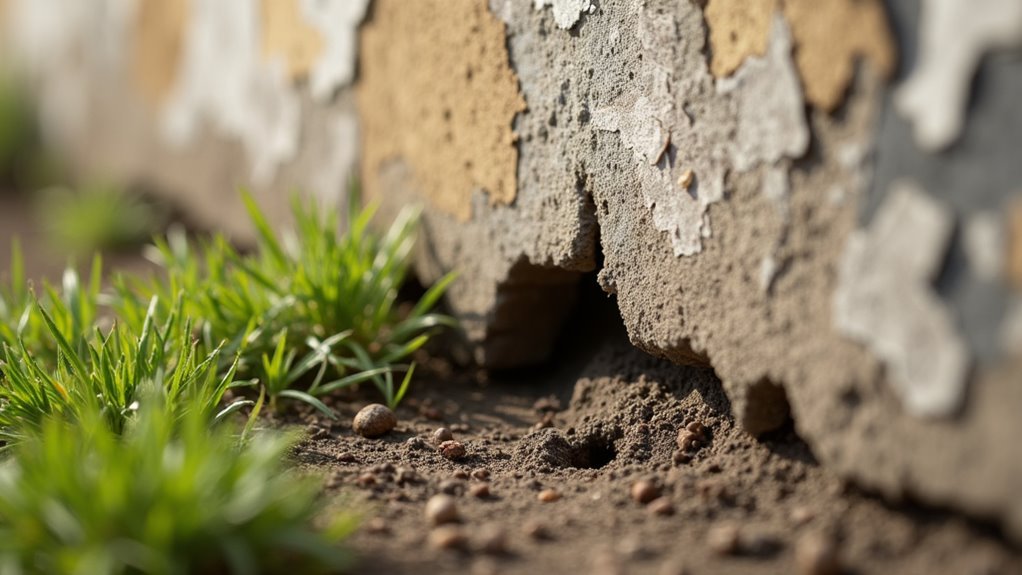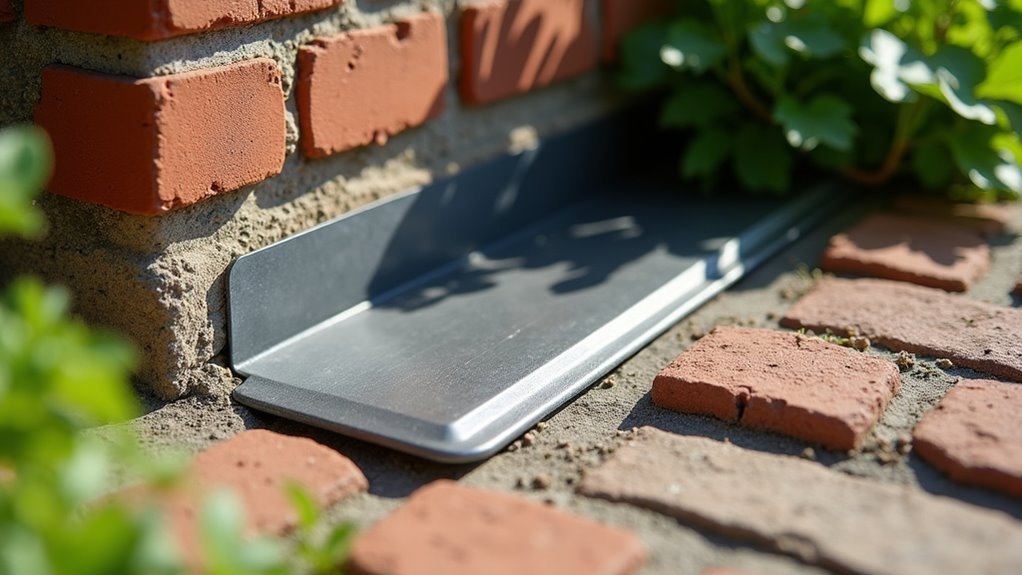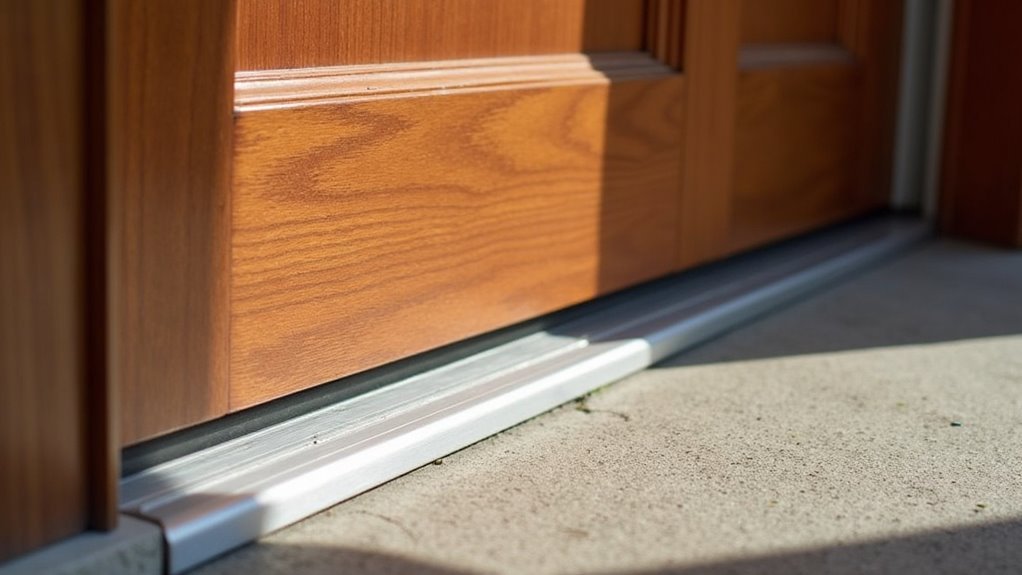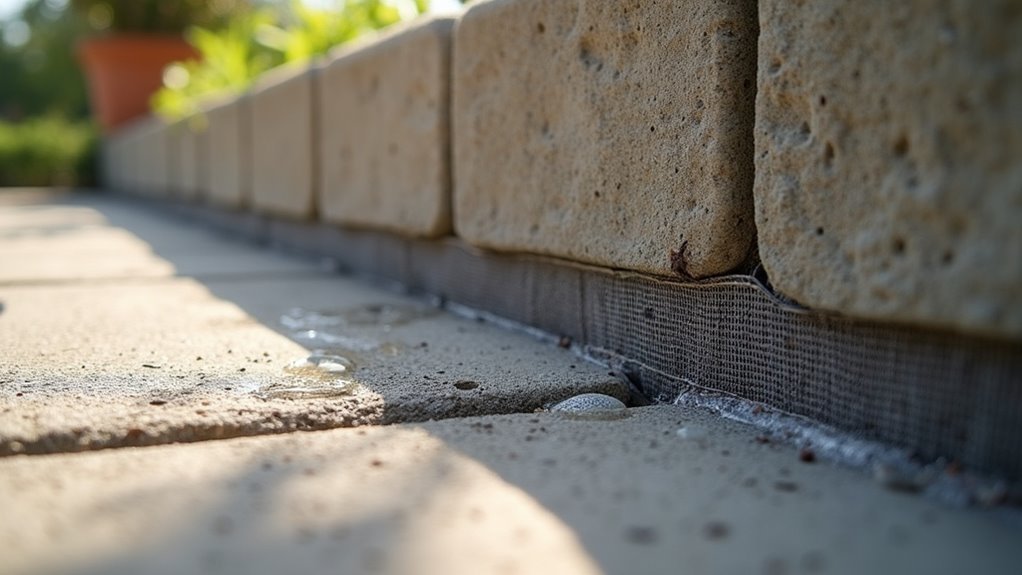You’ll need to inspect your foundation thoroughly for openings as small as a dime, focusing on gaps between siding and foundation, unsealed utility lines, and cracks around windows and doors. Use galvanized sheet metal, stainless steel mesh, and high-quality caulk to seal these entry points effectively. Install professional-grade door sweeps beneath exterior doors and weatherstripping around garage doors. Don’t forget to clear vegetation and materials from your foundation perimeter. Mastering these techniques guarantees thorough protection against persistent rodent invaders.
Identifying Common Foundation Entry Points for Mice

Since mice can squeeze through openings as small as a dime, you’ll need to carefully examine your home’s foundation for potential entry points.
Start by inspecting gaps between your foundation and siding, where installers often leave large openings. Check unsealed areas around utility lines like pipes and cables entering your foundation—these serve as major access points.
Don’t overlook foundation cracks and gaps around windows and doors that mice exploit regularly. Pay special attention to gaping holes around garage steps, which frequently lead directly to basements or crawl spaces.
During inspections, examine meter boxes for holes around power cables. You’ll want to seal any cracks and fill gaps immediately to prevent mice from accessing your home through these vulnerable areas.
Essential Materials and Tools for Foundation Mouse-Proofing
You’ll need professional-grade materials to effectively seal your foundation against mouse intrusion.
Custom-bent galvanized sheet metal provides the most durable solution for gaps between siding and foundation, while specialized sealants offer long-lasting protection in vulnerable areas.
Proper installation requires specific tools like metal brakes and professional-grade applicators to guarantee these materials perform at their maximum effectiveness.
Custom Sheet Metal Solutions
Three key materials form the foundation of effective custom sheet metal mouse-proofing: galvanized steel sheeting, weatherproof sealant, and precision cutting tools. Custom-bent galvanized sheet metal creates an impenetrable long-lasting barrier that’ll seal gaps between your foundation and siding. Unlike traditional materials, rodents can’t chew through metal, making it the superior choice to prevent rodents from exploiting entry points.
You’ll need specialized tools like a metal brake for precise fabrication and tight installation. Install during dry conditions for maximum caulking adhesion.
| Installation Phase | Required Tool | Purpose |
|---|---|---|
| Measuring | Tape Measure | Accurate dimensions |
| Cutting | Metal Brake | Custom bending |
| Sealing | Caulk Gun | Weather protection |
Regular inspections guarantee your metal barriers maintain their effectiveness against mouse infiltration.
Professional Grade Sealants
Professional-grade sealants deliver unmatched protection against mouse infiltration when you choose the right materials for your foundation barriers.
You’ll need high-quality caulk, steel wool, and stainless steel mesh to effectively seal gaps and prevent mice from entering your home. For cracks smaller than 1/4 inch, stainless steel mesh works best since rodents can’t chew through it.
When you apply caulk around utility lines, windows, and doors, you’re creating thorough barriers that professional pest control services recommend.
Custom-bent galvanized sheet metal requires special tools and metal brakes for precise fabrication. These materials to seal entry points must undergo regular inspection and maintenance, as wear compromises effectiveness.
Steel wool combined with caulk provides extra durability for larger openings.
Specialized Installation Tools
Having the right materials means nothing without proper tools to install them effectively. You’ll need specialized tools to achieve professional mouse-proofing results around your foundation.
A metal brake is vital for bending sheet metal to fit specific gap dimensions between your siding and foundation. This tool guarantees custom-fitted barriers that mice can’t penetrate.
Caulking guns are significant for applying sealants and adhesives, creating strong bonds between materials. You’ll use these frequently when installing stainless steel mesh in smaller openings and securing weatherstripping around entry points.
Additional tools include wire cutters for trimming mesh, drill bits for pilot holes, and measuring devices for accurate cuts.
Professional-grade installation requires precision tools that match your mouse-proofing materials’ quality standards.
Sealing Gaps Between Siding and Foundation With Sheet Metal
One of the most effective barriers against mouse infiltration is custom-bent galvanized sheet metal, which you’ll find superior to softer materials that rodents can easily chew through.
This approach gives you complete control over sealing large gaps between your siding and foundation, eliminating potential entry points that mice commonly exploit.
Install the sheet metal during dry weather to guarantee proper caulking adhesion. Focus particularly on corners, where siding installations often leave vulnerable areas unsealed.
The galvanized material’s durability makes it an ideal barrier that resists rodent damage while providing long-lasting protection.
After installation, conduct regular inspections to maintain the sheet metal’s integrity. Check for any loosening or damage that could compromise your foundation sealing efforts and allow future mouse access.
Protecting Utility Entry Points and Meter Boxes

While your foundation and siding provide the primary barrier against mice, utility entry points and meter boxes create some of the most vulnerable access routes into your home.
Meter boxes often contain baseball-sized holes for power cables that become major entry points if you don’t seal them properly. You’ll find similar vulnerabilities around pipes and electrical lines where they enter your house.
Regular inspections are essential to spot gaps or damage that compromise your defenses. When you discover openings, use stainless steel mesh or custom-bent sheet metal to seal these areas effectively.
These materials provide long-lasting protection that prevents rodent access. Don’t overlook these important spots – mice can easily navigate through utility entry points, making proper sealing vital for maintaining a mouse-proof environment.
Weatherproofing Garage and Basement Access Areas
Your garage and basement access areas represent critical vulnerability points that mice exploit to enter your home.
You’ll need to focus on sealing garage doors properly and securing all basement entry points to create effective barriers.
These spaces often connect directly to your home’s interior, making them high-priority areas for thorough weatherproofing efforts.
Garage Door Sealing
Most garage doors create multiple entry points that mice can easily exploit to access your home’s interior spaces.
You’ll need to install weatherstripping around your garage door to create a tight seal that’ll prevent rodent access effectively. Focus particularly on gaping holes around garage steps, as these often lead directly to basements or crawl spaces where mice establish nests.
Seal small openings beneath your garage door using metal flashing or wire mesh rather than plastic materials that rodents can chew through.
Consider installing automated door closers to prevent your garage from being left open unintentionally. Conduct regular inspections of all seals and weatherstripping to maintain their effectiveness and identify new potential entry points before mice discover them.
Basement Entry Points
Basements present numerous vulnerabilities that mice exploit to establish permanent colonies within your home’s foundation. You’ll find basement entry points around utility lines, meter boxes, and step connections that create highways for rodent invasion. Unsealed areas around power cables often feature baseball-sized holes that welcome entire mouse families.
| Entry Point | Risk Level | Sealing Method |
|---|---|---|
| Utility lines | High | Steel wool + caulk |
| Meter boxes | Critical | Hardware cloth |
| Step gaps | Medium | Concrete patching |
| Cable holes | High | Expanding foam |
| Pipe penetrations | Medium | Rubber gaskets |
Focus your efforts on reinforcing utility line seals and eliminating potential nesting sites. Regular inspection prevents mice from transforming your foundation into their permanent residence.
Installing Professional-Grade Door Sweeps and Barriers

Professional-grade door sweeps serve as one of your most effective first lines of defense against mouse intrusions, sealing gaps up to 1.75 inches wide beneath exterior doors where rodents commonly enter.
These specialized barriers create tight seals that prevent rodent entry when properly installed.
To maximize protection, consider these essential installation strategies:
- Choose low-profile or standard rodent-proof door sweeps designed specifically for pest exclusion
- Combine door sweeps with metal flashing to create thorough barriers resistant to gnawing
- Install automated door solutions like the Xcluder Rodent Proof Automatic Door Bottom for enhanced sealing
- Conduct regular maintenance inspections to identify wear and damage
- Replace worn sweeps immediately to maintain effectiveness
Metal components offer superior durability compared to plastic or wood alternatives, ensuring long-lasting protection against persistent rodents.
Long-Term Maintenance for Lasting Mouse Protection
While installing professional-grade barriers provides excellent initial protection, maintaining these defenses requires ongoing vigilance and systematic upkeep to confirm your mouse-proofing efforts remain effective year after year.
Regularly inspect and seal any new gaps or cracks around the foundation, as even small openings can compromise your defenses. Replace deteriorating caulk and conduct seasonal maintenance checks, particularly during fall and spring weather changes.
Clear away firewood and materials from your foundation to eliminate nesting opportunities. Keep vegetation trimmed around the foundation, creating a clear zone that reduces cover and makes holes around entry points more visible.
These Do-It-Yourself Measures confirm consistent protection and help safeguard your home from mice through systematic upkeep.
Frequently Asked Questions
How to Seal Foundation to Keep Mice Out?
You’ll need to inspect your foundation for dime-sized openings, then seal cracks with steel wool and caulk. Install galvanized sheet metal barriers and use weatherstripping around doors to block mice entry points effectively.
How Much Does It Cost to Seal Your House From Mice?
You’ll spend $200-$600 for professional mouse-proofing services, depending on your home’s size and infestation severity. DIY materials like steel wool and caulk cost just $5-$20 each, making self-sealing much more affordable.
How Do I Stop Mice From Digging Under My Foundation?
You’ll need to seal foundation cracks with steel wool or concrete, install metal flashing around the base, clear vegetation from the perimeter, and create gravel barriers to deter digging.
What Is the Best Sealant for Mouse Holes?
You’ll want steel wool combined with caulk for the best results. Steel wool blocks entry since mice can’t chew through it, while caulk seals gaps permanently around the wool barrier.
In Summary
You’ve now got the knowledge to seal your foundation effectively against mice. Remember that consistent maintenance is key—inspect your barriers quarterly and repair any damage immediately. Don’t overlook small gaps, as mice can squeeze through surprisingly tiny openings. By staying vigilant and addressing issues promptly, you’ll maintain a mouse-free home year-round. Your investment in proper materials and techniques will pay off with lasting protection.





Leave a Reply